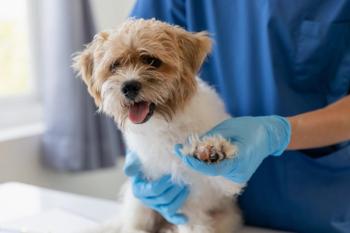
What it takes to feel safe
Equine veterinary professionals learn a lot of safety protocols. But one real danger rarely gets addressed in practiceand that needs to change, these experts say.
Photo: Shutterstock.comWorking with horses comes with obvious dangers: Equine veterinarians can be kicked, bitten, stomped, thrown and maimed. There are protocols readily available for keeping oneself safe from these risks. What doesn't come with a protocol, though, and is potentially just as dangerous, is the threat of harassment and assault from the human holding the lead rope.
When a practitioner visits a remote location solo, perhaps on an emergency visit late at night, she may have no knowledge of what or who she'll find waiting. Perhaps a profession-wide safety protocol-or any proactive step toward alleviating these kinds of threats-is long overdue.
Assault-or just the hint of it
“I recently opened a veterinary practice, and I have no protocols in place,” says Stephanie Freese, DVM, owner of Polaris Equine Mobile Veterinary Clinic in Pittsboro, North Carolina. “No other place I've worked at has had protocols to deal with this kind of safety either.”
Even if overly-friendly comments are well-meaning and free of sinister intent, they often don't sit well with the recipient-especially in the context of what should be a professional relationship. “[A client will] describe your level of care, and then tack on a comment like, ‘You're pretty on the eyes,'” Dr. Freese continues. “I've been cutting off the tail of a dead horse when someone has asked me on a date.”
Fortunately, she's only had to deal with clients' words. “I don't know what I would do if someone was actually aggressive,” she admits. “Realistically, I'm five-foot-one. There's no way I'm defending myself in the field, and I go out to these calls alone almost always.”
Part of Dr. Freese's challenge is that she's building her business from scratch. “I don't know any of my clients yet,” she says. “They're all finding me on the internet, which is actually very scary. I don't think about it, because if I did I wouldn't want to go out there and my business would fail. I tell myself it's no different than the risk I put myself in every day when I'm dealing with a horse. That risk, to me, seems more likely than sexual assault.”
Dr. Freese also wonders about inherent challenges due to the nature of equine practice. “It's hard to see how you could create a protocol that could be effective given how the job works,” she says. “When there's an emergency, you get up and you run to it. And unless you're married to your assistant or have someone with a flexible schedule, you're on your own. Giving someone a call to let you know where you are won't protect you in the moment of an attack. How can you actually protect yourself like that?”
Dr. Freese notes that some equine professionals carry guns but, for her, the risks outweigh the benefits. “The practitioners that have guns keep them in their truck, which gives them peace of mind. But unless it's at your hip, you're going to be too far from your gun,” she says. “It feels even more dangerous to me because it'd be so easy to take from you while you're busy with the horse. It doesn't seem like a foolproof way to ensure safety.”
And finally, what about those creepy clients with deep pockets? What if refusing to treat their horses would harm your financial situation even as it preserved personal safety? “There are times I feel like I can't say no,” Dr. Freese says. “It's tied to my livelihood. … I saw a client last week who said too many creepy things and asked for too many hugs-but he spent two grand in a single visit. And I think, how can I go back there and approach that? But I have to.”
Building a protocol is easier than you'd think
Not long after Dr. Freese spoke with dvm360, we contacted Philip Seibert Jr., CVT, veterinary safety expert and founder of
“A violence-prevention strategy is looked at in the same light as many other prevention strategies,” he explains. “Veterinary professionals often view a plan as a reaction to take if something bad happens. But a plan starts way before that.”
Seibert says he tells veterinarians that when they sense danger, it's important not to overreact but also not to underreact. “If you see someone who's coughing a lot, you can react accordingly rather than assume he has tuberculosis,” he says.
An essential part of knowing the difference is to be prepared for the situation when it occurs. “Just like in medicine, we have to learn about the scenario, prepare for it and create a protocol, and then deal with it when the situation arises,” Seibert says.
The first thing that needs to happen is a frank discussion with your veterinary team-or a mentor, peer group, consultant or other trusted expert if you practice alone, Seibert says. Make a list of clear warning signs that signal potential danger. “Define the difference between criticism or rudeness and threatening behavior,” he says. “At what point do words and behavior become something more? Be realistic.”
The second step is to prepare yourself to respond to the danger-or prevent it in the first place. “If you're going to be out on your own to see people you've never met, you need to take a self-defense course,” Seibert says. “Set up a system where someone knows where you're at when you're away. Whenever you go out to a farm or somewhere else, call your office or someone specific and let them know. Equine vets love their freedom, but that freedom comes with a risk.”
Safety tip: Stash a spare key
Seibert paints a picture of how easily it is to end up in a situation with no escape routes. “If someone has the intention of doing harm to you, it won't take much to just take your keys and throw them away from you,” he says. “It's like a horror movie, when you get to your car and realize your keys are no longer in the ignition.”
The solution? Stash another key inside the vehicle. “Having a spare hidden somewhere inside of your truck ensures that you can get away,” Seibert says. “Once you're in your car and have locked your doors, you can find the spare and get out of there.”
If you're not comfortable packing a weapon, Seibert recommends a few non-firearm tools. “They make cellular panic devices you can carry on your person,” he explains. “They work like Life Alert, except when you push the button to summon help, it's not because you've fallen and can't get up but because you need help. I also highly recommend investing in dash cams to put on the front and back of your car. If something happens, you always have video evidence to back your claim up.”
And if a client gives you the creeps but you're not ready to cut him loose just yet, Seibert is stolid in his assertion that there's always something you can do to remain secure. “You control the environment and situation you're in,” he says. For example, you can request that a horse be moved into an open area near where your truck is parked. “You don't have to go into that old raggedy barn in the back with someone you don't trust.”
Safety from assault involves the whole team
Of course, the issue at hand is about more than just protocols. It's about support. It's about discussion. “As someone who's mostly been an associate, I want to feel like my bosses have my back in these situations,” Dr. Freese says. “The associates out there receiving this sort of unwanted attention don't want to do something wrong. There needs to be dialogue with a manager or owner-someone who says, ‘If something happens, leave. Call me, text me. Do what you need to do.' I've never had a boss say that to me-and I've worked for a lot of different people.”
Seibert agrees. “Managers and owners should go over scenarios with their teams,” he says. “Role play what could happen and how to get out of a tight spot. One thing I suggest is to ‘accidentally' drop a syringe and say, ‘Oh, shoot, I contaminated that-let me go to my car and get a new one.' Then get in your truck and lock the door and make a call or get somewhere safe.
“If there's any instance at all of inappropriate behavior,” Seibert continues, “there needs to be a mechanism in the practice to investigate it. It might be as simple as the employee putting a note in the record saying, ‘This guy is harmless but piles on the dirty jokes.' Then the manager or owner can decide if they need to pick up the phone and have a discussion with that client.”
Clearly, the conversation is far from over. But starting a dialogue and creating the right protocol is a great start. And it helps immensely to keep a healthy sense of perspective, Dr. Freese has found.
“I've lived on three different continents and I've met people from everywhere,” she says. “Generally speaking, the vast majority are good people.” She laughs. “Horse people are crazy, but they're my kind of crazy.”
Newsletter
From exam room tips to practice management insights, get trusted veterinary news delivered straight to your inbox—subscribe to dvm360.






